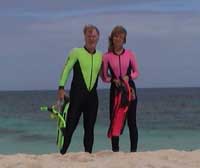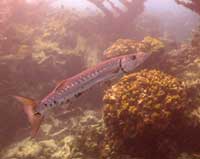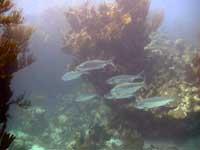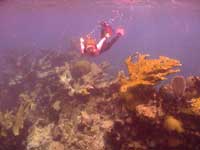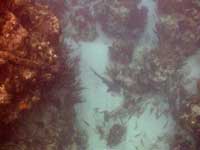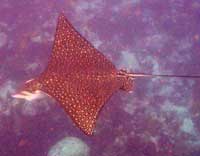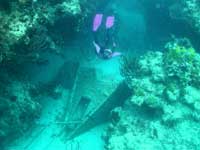 |
||||||||||||||||||||||||||||
After breakfast we hopped in our 4-wheel drive truck to investigate a break in the barrier reef on the east side of Anegada Island that we discovered yesterday. Lawrence (owner of Anegada Reef Hotel) told us that the area we saw is called Loblolly Beach. He said that if the sea conditions were good this was a good place to snorkel. We drive down a empty sandy road that ends at a deserted beach that faces the Atlantic Ocean. We stop our truck and walk a short distance to the soft, white sand beach. For as far as we can see there is no one on the beach or in the water. We don't even see any boats! The reef here looks close to the shore. We can see small waves breaking on a reef about 300 feet from the shore. We stand at the water's edge to check the sea conditions. We can see that there is a strong current. It flows in from the ocean and flows parallel along the beach. The current is due to the waves pushing the water across the shallow reef and the strong wind we can feel. At least if we have problem with the current it will bring us back to shore and not out to sea. The water looks clear and fairly calm so we decide this is a good place to explore the reef. Back at the truck we collect our skin diving equipment. Today we will be dressing a lot lighter than we have for all our other dives. Skin diving uses only a mask, snorkel and fins. We will not be wearing all of our other scuba diving equipment. Without our air tanks we can only stay underwater for as long as we can hold our breath. With our snorkels we can breathe with our faces in the water so we can see what is under the water. We put on our masks and fins and wade into the water. Just as I (Wayne) am about to lay down in the water and snorkel away Karen yells, "Look out for that shark!" She points to a large, dark shape headed right for us! It is over 4 1/2 feet long! I stop and watch as it swims past me, about 8 feet away. Then I put my face in the water to see what it is. It is not a shark, but it is a large barracuda! Fortunately we know that barracudas are just curious. Even though it looks scary and has big, sharp teeth we know it is not going to bother us. We snorkel behind the barracuda, following it until in finally speeds away. (Maybe the barracuda thinks we are scaring away the fish it is looking to eat.) Close to shore, the water here is shallow. The sandy bottom is only about 4 feet deep. The coral reef comes close to the beach here. The reef rises up from the sandy bottom like a thick wall. The top of the reef is sometimes less than 1 foot under the water. The reef is too shallow to swim over so we swim through cuts and openings in the reef. It is like being in a maze. Fish swim through the coral maze and in and out of holes in the reef. It seems like they are playing hide and side with us. Looking at the reef we can see that many of the corals are dead, with some patches of healthy, young corals scattered across the reef. As we swim further from shore the water gets deeper. The reef is now like a small Grand Canyon. The cuts in the reef are now deep canyons. Deep caves and tunnels cut into reef like swiss cheese. We swim down to the entrance of these caves and tunnels and peer into the darkness. If we had our scuba equipment we would investigate some of these tunnels. Since we are only holding our breath we do not want to take the chance of getting trapped inside a tunnel without an emergency air supply. We can feel the current getting stronger and the force of the waves increasing, too. We are getting close to the break in the reef that leads out to the ocean. As the waves break around us the foam makes it hard to see. We kick hard with our fins to push through the breaking waves and our into the ocean. Finally the waves stop breaking around us and the currents slackens. We have come through the cut in the reef and are now beyond the barrier reef and in the Atlantic Ocean. The bottom is now 35 feet below us. The canyon walls of the reef widen and deepen. The top of the reef is now about 6 feet under the water. Holding our breath we swim across the top on the reef and down into another, narrower canyon. As we swim around the corner in the canyon we almost collide with some huge fish swimming in our direction. These prehistoric-looking fish are huge tarpon, about 5 feet long! These big fish have big silvery scales, and a turned-up mouth, like a bulldog. They look scary but these large fish are quite harmless. We surprised the tarpon as much as they surprised us and they quickly turn around and swim in the opposite direction. As we swim slowly along the surface we can see the top of the reef is covered with a huge elkhorn coral forest. Most of the elkhorn corals are gigantic. We swim down next to the elkhorn corals and see that they are bigger and longer than we are, even with our fins on! Most of the elkhorn corals are dead. We think about the dead elkhorn corals we saw on Day 4 near Ginger Island. Could these corals have been killed off at the same time and by the same thing that killed the elkhorn corals by Ginger Island? At the bottom of one of the canyons we see a large, dark shape that makes us stop and look at it more closely. It is a shark! It is about 5 feet long! By the shape of the shark and because it is laying on the bottom and not swimming, we can tell it is a nurse shark. (Remember our nurse shark on Day 3?) We swim down to the shark to get a closer picture, but before we take the picture the shark turns and swims away, afraid of us getting too close. We are now about 1/4 mile from the shore. The bottom is now about 50 feet below us. We are at the edge of the coral plateau. If we are going to see any big fish this is where we expect to see them, out in the deep water. Swimming along the edge of the drop-off we can a large, dark shape swimming in our direction. It is a huge, spotted eagle ray! It is over 6 feet across. It slowly glides past us like a sleek jet fighter on patrol. Its jutting head and the white spots and circles that cover its dark back make it the prettiest of the rays that live in the Caribbean Sea. The eagle ray does have stinger at the base of its tail, but it quite harmless to people. We try to swim along with it, but with a flick of its wing-like fins it speeds off into the blue. We have now been snorkeling for over an hour and 45 minutes and we are a long way from shore. It is time to head back to the beach. As we swim back across the reef we wonder if we have swum across any old shipwrecks that are now covered in coral. As we approach the cut in the reef we kick hard with our fins to get through the waves and back inside the reef. It is easier coming in than going out since the water current is going in our direction. We swim down a canyon that we have not explored yet. Off to the side, at the mouth of a tunnel we see are strange shape. It is not a shark, or a ray. It is a shipwreck! It is only the front of the boat (bow). The rest of the boat is in pieces in the tunnel and along the canyon. It was probably about 50 feet long. No sunken treasure on this boat. It is not that old. We can see it is fiberglass and it is not covered with corals. It was probably trying to get inside the reef through the same cut that we just came through. This close to shore we hope everyone who was on the boat got to land alright. We carefully make our way through the coral maze and safely back to the beach. We have had an excellent day of snorkeling and would love to have had more time, and our scuba equipment, to explore this reef more closely. This is the most exciting reef we have explored so far on our expedition. It is not that the corals are more healthy, but that the corals make interesting mazes to explore. We also liked all the big fish we saw today, too. Now it is time for us to return to our hotel and pack up because tomorrow we fly back to Virgin Gorda and start our land explorations. Join us tomorrow for a look at what makes Virgin Gorda so interesting above water.
Best Fishes, . |
TODAY'S DATA Loblolly Beach, Anegada Island Position: 18º 43' N / 64º 22' W Setting up our camera on some pieces of dead coral allows us to take a picture of ourselves ready to dive in and explore Anegada's reefs.
We found this 4 1/2+ foot long barracuda close to the beach. We followed it until it finally sped away.
These huge tarpon (5 feet long) are swimming away after we surprised them by accident. (Enlarge the picture and see how many tarpon you can count in this school.)
Karen swims across a forest of elkhorn coral. The elkhorn corals are all dead except the younger, smaller elkhorn in the front and to the right of Karen.
We found a nurse shark (5 feet long) resting at the bottom of this coral canyon. (Enlarge the picture for a closer look. Hint - He is in the middle of the picture.)
A beautiful spotted eagle ray (6 feet wide) swims by us in deep water.
Karen snorkels down into a coral cayon to investigate the bow of a shipwreck. |
|||||||||||||||||||||||||||
home | basecamp | archives | library | other expeditions | kids' page | contact us © 2002, The Ocean Adventure All rights reserved. |
